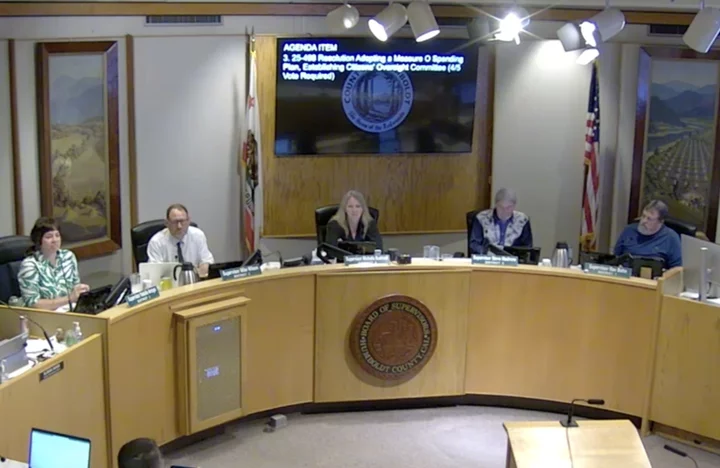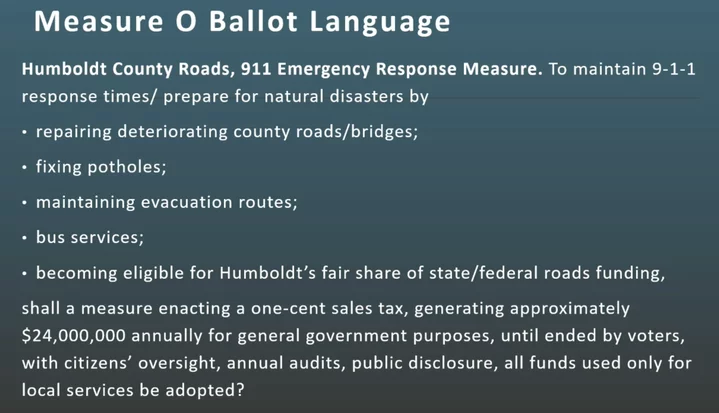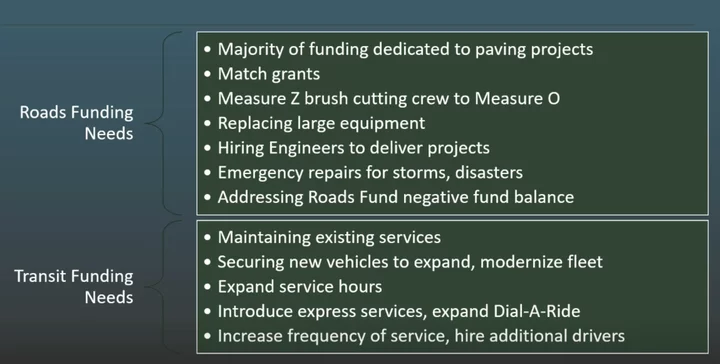The Humboldt County Board of Supervisors (from left): Fourth District Supervisor Natalie Arroyo, Third District Supervisor Mike Wilson, Second District Supervisor (and board chair) Michelle Bushnell, Fifth District Supervisor Steve Madrone and First District Supervisor Rex Bohn.
###
The Humboldt County Board of Supervisors this week decided how to divvy up the first five years of proceeds from a new a new one percent countywide sales tax, which voters approved in November by passing Measure O, the “Humboldt County Roads, 911 Emergency Response Measure.” Eighty-five percent will go toward roads, with the remaining 15 percent going toward transit.
The tax is projected to generate $24 million per year for the county’s General Fund, and officials have publicly committed to spending those revenues on road improvements and public transportation projects, as promised in the measure’s ballot language:
The big debate, since the measure passed, has been: what percentage of those precious revenues should go toward road repairs versus public transit. On Tuesday, after a couple hours of sometimes tense deliberations, the board voted unanimously to approve the 85/15 split.
However, the proceedings left some public transportation advocates crying foul. Here’s why:
The staff report prepared for the matter said a four-fifths supermajority vote was required for the board to pass a motion regarding allocations of Measure O proceeds. However, more than an hour into board deliberations, County Administrative Officer Elishia Hayes said that wasn’t actually the case.
“Technically, for the resolution to pass today … you can get that through with three-two,” Hayes remarked. She said staff wanted the board to reach the higher threshold because this decision was related to the county budget, and future budget revisions and transfers will require a four-fifths vote.
“So we really need your board to be on a 4-1 with this so that we know that we’re in consensus,” Hayes said.
“I wish you would have made that clear earlier,” Fifth District Supervisor Steve Madrone said, “because I was completely under the impression that this needed a four-fifths vote because it’s an allocation of funding.”
The fraction mattered because ideologically, the board fell into two distinct camps in this issue, with First District Supervisor Rex Bohn and Second District Supervisor Michelle Bushnell wanting to give the lion’s share (as much as 95 percent) of Measure O proceeds to road repairs while Madrone, Third District Supervisor Mike Wilson and Fourth District Supervisor Natalie Arroyo said public transit — and the Humboldt Transit Authority, specifically — should get as much as 20 percent.
Madrone’s objection, which was subsequently echoed by Wilson and other public transportation advocates, was that the board majority might have played a bit more hardball in negotiations if they knew they could push their preference through without compromise.
Reached by the Outpost on Friday, Colin Fiske, executive director of the nonprofit Coalition for Responsible Transportation Priorities (CRTP), said that while he’s grateful that the supervisors approved a meaningful amount of funding for public transit, they could very well have allocated more if the process had been properly framed from the outset.
“It was clear from the discussion that the majority of supervisors thought it should be more,” he said, “but the incorrect listing of a four-fifths vote requirement slanted the discussion and resulted in a smaller amount for transit. That is very troubling.”
Tom Wheeler, executive director of the Environmental Protection Information Center (EPIC), agreed, saying his organization is “alarmed that the staff repeatedly misrepresented the required vote threshold and seemingly did so in order to make a vote to robustly fund transit more difficult.”
In a statement to the Outpost, Humboldt County Public Information Officer Cati Gallardo confirmed that staff’s recommendations could have been passed by a 3-2 vote. She continued:
However, under Government Code Section 29125, certain transfers and revisions to the adopted budget made after the Budget Hearings require a four-fifths vote. Since such adjustments are common throughout the fiscal year, staff aimed to establish as much consensus as possible during these initial budgeting decisions to prevent conflicts later on.
Because the agenda items related to Measure Z, Transient Occupancy Tax (TOT), and Measure O were complex, at times contentious and would directly impact the county’s overall budget and community services in a significant way, the County Administrative Office requested that the Board work toward a higher level of agreement. Achieving a super majority vote of four-fifths helps ensure smoother and more efficient budget administration moving forward.
The wording of this explanation — staff “aimed” to achieve consensus and “requested” a higher level of agreement — still differs from the language of the staff report, which said a four-fifths vote was “required.”
Prior to the board’s deliberations, an ad hoc committee met in February to hash out a recommendation. The committee comprised Wilson, Madrone, Fiske and representatives from the Humboldt County Association of Governments (HCAOG), the Humboldt Transit Authority, the Humboldt Builders’ Exchange, the Building and Construction Trades of Humboldt and Del Norte Counties and the McKinleyville Community Services District.
Their recommendation was to split the first five years of revenue 86/14, roads v. transportation — very close to what the supervisors landed on — while including a one-time contribution of $3 million to a Measure O contingency fund to be used if there’s an economic downturn.
In presenting the item to the board, Deputy County Administrative Officer Sean Quincey noted that the county will have $500 million-worth of road pavement needs over the next five years, and the county’s roads fund is already $7 million in the negative.
Local roads have been in bad shape for years. They’re rated “poor” on the state’s pavement conditions index, and they on track to hit “failed” status by 2033, Quincey said.
During the public comment period, half a dozen people urged the board to give a full 20 percent of proceeds to public transit. Arcata resident Peggy Martinez, for example, said, “You all have constituents that would take the bus if there were [more] buses available.”
The county’s interim auditor-controller, Mychal Evenson, also addressed the board, telling them that the increased financial activity related to Measure O will mean a lot more work for his office.
“I fear that we’re going to see delays in payments,” he said. “Roads invoices are among the most complex that we do.”
Evenson asked that one percent of Measure O revenues be allocated to his own office. Bushnell later excoriated him for making this request at the last minute in a public setting.
“I think you had an opportunity to engage the CAO and this board prior to making public comment today, and it is not necessarily the place to do it right now,” Bushnell said. “I don’t appreciate that coming out of public comment time at all.”
Still, as noted above, most of the board’s discussion centered on how to split the revenues over the next five fiscal years. Arroyo, who serves as chair of the Humboldt Transit Authority’s board of directors, said that agency serves an average of 40,000 passengers per month. She also noted that 21 percent of county residents are seniors and 19 percent are disabled.
Arroyo also advocated for giving a portion of any excess revenues above projections to transit, rather than having them go entirely to roads.
Bohn, on the other hand, said most of the people he’s spoken with — including many backers of Measure O — haven’t mentioned bus service at all, whereas he hears all the time from constituents complaining about the condition of county roads. He said he’d like to give just 10 percent of Measure O proceeds to transit, “but I don’t know if that would fly.”
Wilson, like Madrone, was a bit thrown by the revelation that a four-fifths supermajority was not required. He said he came into the meeting with a goal of getting transit’s share up to 16 percent, but later split the difference between that and the staff recommendation, requesting 15 percent.
Following a bit of debate over how to allocate any excess funds above revenue projections, Bushnell made an impassioned argument for giving most of it to roads, given the existing budget deficit and the season-dependent scheduling of road maintenance projects.
“I just really, really, really have to advocate that we’re in a mess in the roads department fiscally,” she said. “Can we please give some money to the roads department to try to make up for their issues right now?”
The motion that finally passed unanimously, offered by Madrone with a little tweak proposed by Quincey, was a bit complex. In addition to the 85/15 split, it called for:
- Public Works to aim for spending five percent of its allocations on Complete Streets measures;
- staff to develop a plan for providing help to the Auditor-Controller’s Office;
- the anticipated $6 million in revenue generated during the current fiscal year (through June 30), plus all future revenue in excess of the projected $24 million per year to be split 50/50, with half going toward road projects while the other half goes toward retiring the debt in the roads division until that debt is paid off; and
- after that, all excess proceeds to be be split 85/15, roads v. transportation.
Again, that motion passed 5-0. Measure O’s passage brought Humboldt County’s cumulative sales tax rate up to 8.75 percent. The sales tax rates in Humboldt’s incorporated cities range from 9.5 percent (Ferndale, Rio Dell, Trinidad and Fortuna) to 10.25 percent (Eureka and Arcata). Blue Lake’s is 9.75 percent.
Below is a list of the key needs identified for both roads and transit in the county’s unincorporated areas.
Screenshot.



CLICK TO MANAGE